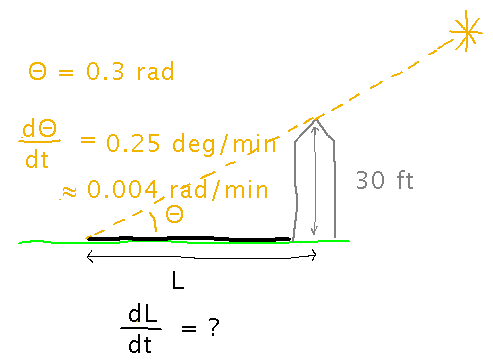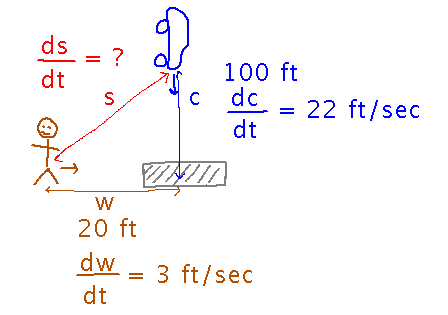Misc
Colloquium next week:
Dr. Robert Rogers, SUNY Fredonia
“Where Am I Ever Going to Use this Stuff?”
Wednesday (October 16), 2:30 - 3:30 PM, Newton 201
Extra credit for going and writing a paragraph explaining connections you make to the talk.
Questions?
Related Rates Problems
Section 4.1
Key Idea(s)
These problems ask for a derivative of some quantity calculated from other quantities.
How to solve these problems
- Write down what you’re given, with a picture
- Express the quantity whose derivative you want in terms of the other quantities
- Consider using Leibniz notation (dy/dx) to keep variables straight
- Take the derivative, typically using the chain rule
- Plug in numbers from the problem.
Silo
There’s an old silo in the field behind my house that casts a shadow across the field as the sun rises:

How fast does the shadow move across the ground when the sun is about 17 degrees (0.3 radians) above the horizon?
Start with “express the quantity whose derivative you want in terms of the other quantities.” In this case the key realization is that two of the numbers in the problem let you compute the tangent of the important angle:

Now take derivatives with respect to t (which forces you to use the chain rule on any terms involving Θ), simplify, and finally plug in the numbers you know for Θ and dΘ/dt.

Notice another advantage of Leibnitz notation in these problems: it makes the chain rule look very much like multiplication of fractions with cancellation, which can (1) be a good way to remember the chain rule in general, and (2) can help you see where and how to use it in related rates problems, e.g., if you find yourself calculating dy/dx and what you need is dy/dz, the Leibnitz form chain rule notation suggests multiplying by dx/dz.

Pedestrian and Car
(A “real world math bounty” problem from a past offering of this course.)
A pedestrian and a car are approaching a crosswalk at right angles to each other. How fast is the separation between them changing?

Use the Pythagorean Theorem to relate w, c, and s.

Now differentiate:

Next
More practice with related rates.
We’ll simplify the pedestrian-and-car result and plug in numbers.
We’ll also look at some more examples.